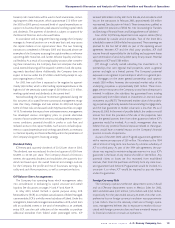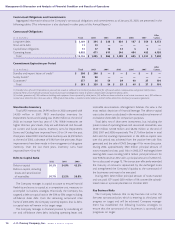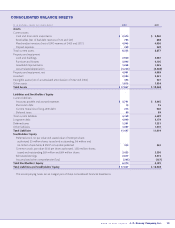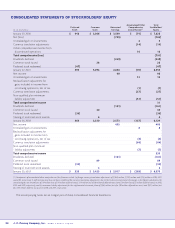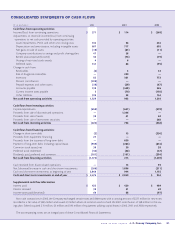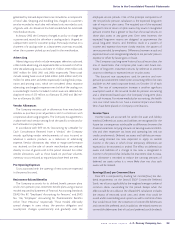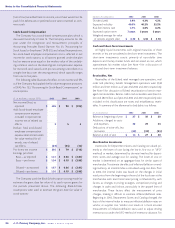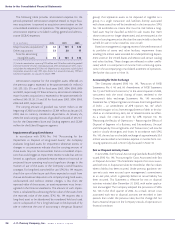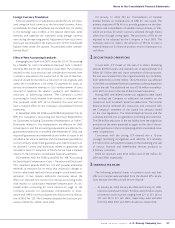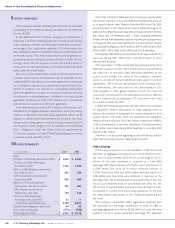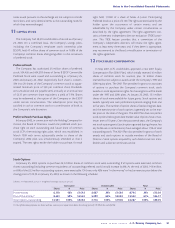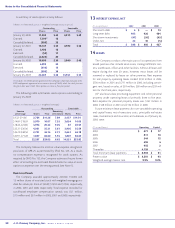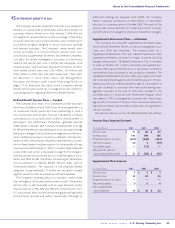JCPenney 2002 Annual Report Download - page 26
Download and view the complete annual report
Please find page 26 of the 2002 JCPenney annual report below. You can navigate through the pages in the report by either clicking on the pages listed below, or by using the keyword search tool below to find specific information within the annual report.
2002 annual report J. C. Penney Company, Inc. 23
Notes to the Consolidated Financial Statements
generated by licensed departments are included as a component
of retail sales. Shipping and handling fees charged to customers
are also recorded as retail sales with related costs recorded as cost
of goods sold. An allowance has been established for estimated
merchandise returns.
In January 2002 the Company changed its policy to charge the
customer and record the sale when a catalog order is shipped to
a department store for customer pickup. Previously, revenue on a
shipment of a catalog order to a department store was recorded
when the customer picked up and paid for the merchandise.
Advertising
Advertising costs, which include newspaper, television, radio and
other media advertising, are expensed either as incurred or the first
time the advertising occurs, and were $1.1 billion, $947 million and
$967 million for 2002, 2001 and 2000, respectively. These totals
include catalog book costs of $260 million, $269 million and $312
million for 2002, 2001 and 2000, respectively. Catalog book prepa-
ration and printing costs, which are considered direct response
advertising, are charged to expense over the life of the catalog, not
to exceed eight months. Included in other assets are deferred cat-
alog book costs of $73 million as of January 25, 2003 and $86 mil-
lion as of January 26, 2002.
Vendor Allowances
The Company receives cash or allowances from merchandise
vendors as purchase price adjustments and in connection with
cooperative advertising programs. The Company has agreements
in place with each vendor setting forth the specific conditions for
each allowance or payment.
In accordance with EITF 02-16, “Accounting by a Reseller for
Cash Consideration Received from a Vendor,” the Company
records qualifying vendor reimbursements of costs incurred to
advertise a vendor’s products as a reduction of advertising
expense. Vendor allowances that relate to margin performance
not attained on the sale of certain merchandise are credited
directly to cost of goods sold in the period received. For other
vendor allowances, such as those based on purchase volumes,
inventory cost is reduced as required purchase levels are met.
Pre-Opening Expenses
Costs associated with the opening of new stores are expensed
in the period incurred.
Retirement-Related Benefits
The Company accounts for its defined benefit pension plans
and its non-pension post-retirement benefit plans using actuarial
models required by Statement of Financial Accounting Standards
(SFAS) No. 87, “Employers’ Accounting for Pensions,“ and SFAS
No. 106, “Employers’ Accounting for Postretirement Benefits
Other Than Pensions,” respectively. These models effectively
spread changes in asset values, the pension obligation and
assumption changes systematically and gradually over the
employee service periods. One of the principal components of
the net periodic pension calculation is the expected long-term
rate of return on plan assets. The required use of the expected
long-term rate of return on plan assets may result in recognized
pension income that is greater or less than the actual returns on
those plan assets in any given year. Over time, however, the
expected long-term returns are designed to approximate the
actual long-term returns, and therefore, result in a pattern of
income and expense that more closely matches the pattern of
services provided by employees. Differences between actual and
expected returns are recognized gradually in net periodic pension
expense or offset by future gains or losses.
The Company uses long-term historical actual return data, the
mix of investments that comprise plan assets and future esti-
mates of long-term investment returns by reference to external
sources to develop its expected return on plan assets.
The discount rate assumptions used for pension and non-
pension post-retirement benefit plan accounting reflect the rates
available on AA rated corporate bonds on October 31 of each
year. The rate of compensation increase is another significant
assumption used in the actuarial model for pension accounting
and is determined based upon the Company’s long-term plans
for such increases. For retiree medical plan accounting, the health
care cost trend rates do not have a material impact since dollar
limits have been placed on Company contributions.
Income Taxes
Income taxes are accounted for under the asset and liability
method. Deferred tax assets and liabilities are recognized for the
future tax consequences attributable to differences between the
financial statement carrying amounts of existing assets and liabil-
ities and their respective tax bases and operating loss and tax
credit carryforwards. Deferred tax assets and liabilities are meas-
ured using enacted tax rates expected to apply to taxable
income in the years in which those temporary differences are
expected to be recovered or settled. The effect on deferred tax
assets and liabilities of a change in tax rates is recognized in
income in the period that includes the enactment date. A valua-
tion allowance is recorded to reduce the carrying amounts of
deferred tax assets unless it is more likely than not that such
assets will be realized.
Earnings/(Loss) per Common Share
Basic EPS is computed by dividing net income/(loss) less divi-
dend requirements on the Series B ESOP Convertible Preferred
Stock, net of tax as applicable, by the weighted average number of
common shares outstanding for the period. Except when the
effect would be anti-dilutive, the diluted EPS calculation includes
the impact of restricted stock units and shares that could be
issued under outstanding stock options as well as common shares
that would result from the conversion of convertible debentures
and convertible preferred stock. In addition, the related interest on
convertible debentures (net of tax) and preferred stock dividends


